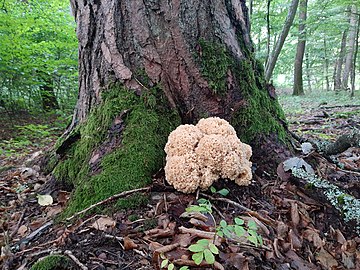Sparassis crispa
| Sparassis crispa | |
|---|---|

| |
| Scientific classification | |
| Domain: | Eukaryota |
| Kingdom: | Fungi |
| Division: | Basidiomycota |
| Class: | Agaricomycetes |
| Order: | Polyporales |
| Family: | Sparassidaceae |
| Genus: | Sparassis |
| Species: | S. crispa
|
| Binomial name | |
| Sparassis crispa | |
| Synonyms | |
| |
| Sparassis crispa | |
|---|---|
| Smooth hymenium | |
| No distinct cap | |
| Hymenium attachment is irregular or not applicable | |
| Lacks a stipe or is bare | |
| Spore print is white to cream | |
| Ecology is saprotrophic | |
| Edibility is choice | |
Sparassis crispa is a species of fungus in the family Sparassidaceae. It is sometimes called cauliflower fungus.[1]
Description
S. crispa grows in an entangled globe that is up to 60 centimetres (24 inches) in diameter. The lobes, which carry the spore-bearing surface, are flat and wavy, resembling lasagna noodles, coloured white to creamy yellow. When young they are tough and rubbery but later they become soft. They are
The spore print is cream, the smooth oval spores measuring about 5–7 µm by 3.5–5 µm.[3][2] The flesh contains clamp connections.[4]
Similar species
The less well-known S. brevipes, found in Europe, can be distinguished by its less crinkled, zoned folds and lack of clamp connections.[4][2]
Distribution and habitat
This species is fairly common in Great Britain and temperate Europe (but not in the boreal zone). It is a brown rot fungus, found growing at the base of conifer trunks, often pines, but also spruce, cedar, larch and others.[4][2]
In the North American Pacific Northwest, it can be found from August to November.[5]
Uses
It is considered a good
See also
References
- ^ a b Roger Phillips (1998). Mushrooms and other fungi of Great Britain & Europe. Cavaye Place, London SW10 9PG: Pan Books. p. 255.
{{cite book}}: CS1 maint: location (link) - ^ ISBN 978-0-691-18037-3.
- ^ ISBN 978-0-340-39935-4.)
{{cite book}}: CS1 maint: location (link - ^ ISBN 978-0-9572094-2-8.}
- ^ "Seasonal Chart for Edible Mushrooms". Central Oregon Mushroom Club. Retrieved 2024-03-31.
- ISBN 2-7373-2275-8.)
{{cite book}}: CS1 maint: location (link - ISBN 978-0-7627-3109-1.
External links
 Media related to Sparassis crispa at Wikimedia Commons
Media related to Sparassis crispa at Wikimedia Commons


